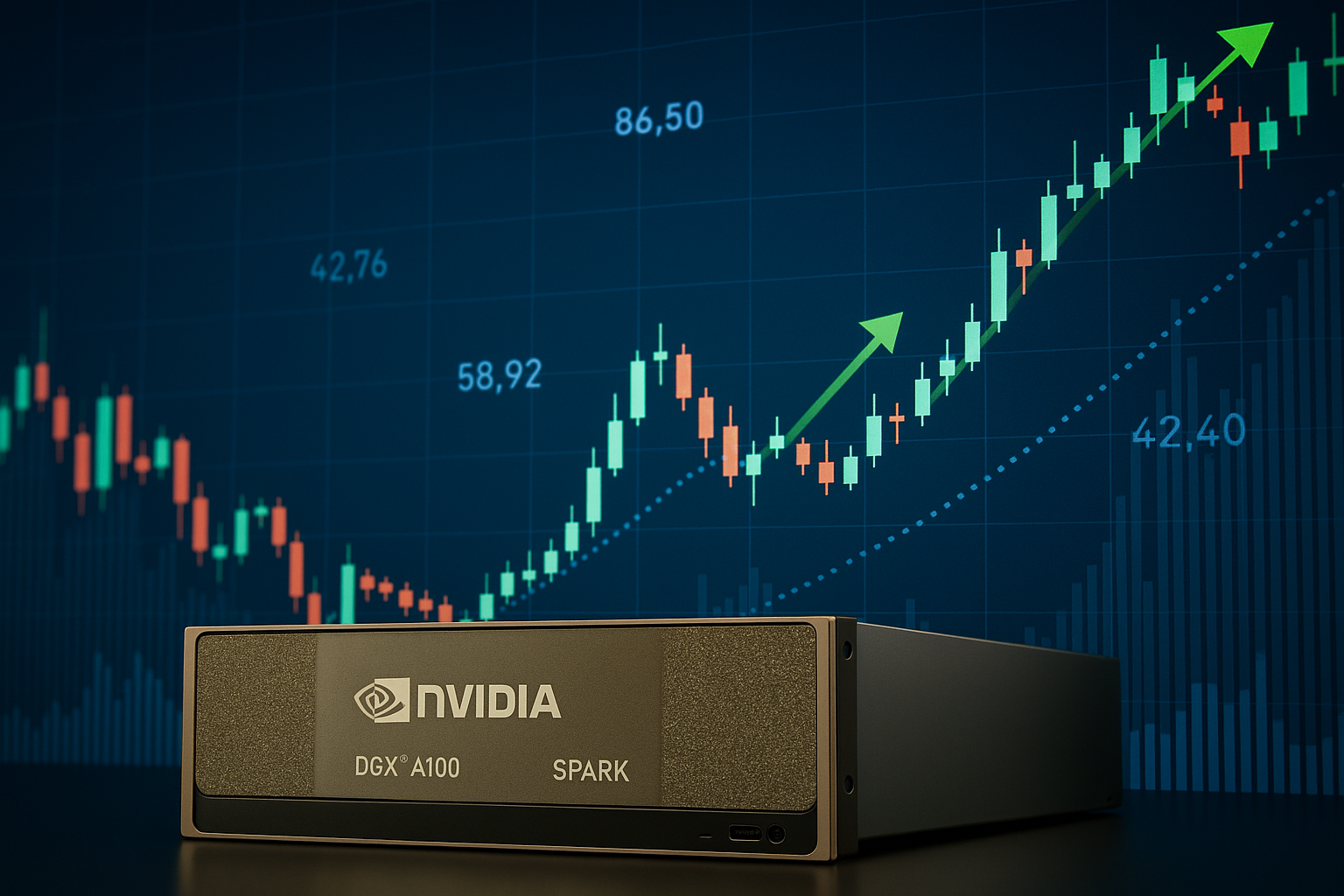
In the world of Artificial Intelligence, no other company has been able to match the dominance that Nvidia (NASDAQ: NVDA) has, and this continues with the soon to be released DGX Spark. This device isn't just a minor addition—it's a revolutionary compact AI supercomputer that brings large language models and CUDA to a mini pc form factor, boasting immense AI compute power, unified memory, and efficiency that outpaces rivals. As investors hunt for resilient AI stocks in a maturing market, Nvidia stands tall, fueled by its hardware-software synergy and ecosystem lock-in. With shares surging in 2025 on record revenues and bullish forecasts, the DGX Spark could ignite further growth, cementing Nvidia as the go-to for AI innovation.
The Rise of Personal AI Supercomputing: Why Desktop Power Matters
To grasp the DGX Spark's impact, consider the evolution toward personal and edge AI. Historically, heavy AI tasks—like fine-tuning large language models (LLMs) or inferencing on vast neural networks—demanded cloud infrastructure or bulky servers, often powered by Nvidia's own high-end GPUs. But data privacy, real-time needs, and escalating cloud costs are driving a pivot to localized AI, where models run on personal devices like mini-PCs or workstations without constant connectivity.
Nvidia, the undisputed leader in AI accelerators, has accelerated its push into personal computing. The DGX series, known for enterprise supercomputers, now extends to the Spark—a "personal AI supercomputer" designed for high-throughput AI in small footprints. It's tailored for developers, researchers, and data scientists building edge applications, from robotics to smart cities, making advanced AI accessible beyond data centers.
Unpacking the DGX Spark: Specs That Redefine Compact AI
The DGX Spark's core is the GB10 Grace Blackwell Superchip, integrating CPU, GPU, and AI acceleration. Fabricated on an advanced process, it features a 20-core Arm CPU (10 Cortex-X925 performance cores and 10 Cortex-A725 efficiency cores) for versatile computing. Base clocks aren't specified, but it handles multithreaded AI workloads efficiently.
Its standout is the integrated Blackwell GPU with 5th-generation Tensor Cores, delivering up to 1 petaFLOP (1,000 TOPS) of AI performance at FP4 precision using sparsity—enough to prototype, fine-tune, and infer models up to 200 billion parameters locally. With 128GB of unified LPDDR5X memory (shared across CPU and GPU) at 273 GB/s bandwidth, it eliminates data shuttling bottlenecks, enabling seamless execution of quantized models.
For perspective, quantized LLMs like Llama 3 or DeepSeek—optimized for coding and reasoning - should run on the DGX Spark without cloud reliance. Quantization compresses models (e.g., FP16 to FP4), and with its massive memory, it supports large-parameter workloads that dwarf consumer hardware. Networking via ConnectX-7 (200Gb/s RDMA) allows clustering two units for 256GB memory, handling up to 405B-parameter models. Storage options reach 4TB NVMe, all in a palm-sized form factor (150x150x50.5mm, 1.2kg).
Power Efficiency: Desktop-Friendly Without Sacrifices
The DGX Spark's 170W TDP makes it remarkably efficient for its power, suitable for desktops, labs, or portable setups. It consumes far less than traditional GPU rigs for equivalent AI tasks, thanks to Arm architecture and optimized Blackwell cores. In developer workflows, it sustains high loads without thermal throttling, ideal for all-day fine-tuning or inference.
This efficiency stems from Nvidia's chiplet design and power gating, allowing AI on the go—think prototyping robotics models in a field lab or generating images during travel, all while sipping power via USB-C.
Dominance in AI Ecosystems: Nvidia's Software Mastery
Hardware wins battles, but ecosystems win wars. Nvidia excels here with its CUDA platform, TensorRT for inference optimization, and RAPIDS for data science—all preinstalled on DGX OS (Ubuntu-based). It supports open-source tools like llama.cpp via CUDA backend, with recent enhancements boosting GPU acceleration for LLMs.
Head-to-Head: DGX Spark vs. AMD Ryzen AI Max+ 395
Comparing to AMD's Ryzen AI Max+ 395 reveals Nvidia's edge. Both offer 128GB unified memory and target desktop AI, but DGX Spark's 1,000 TOPS dwarfs AMD's 50+ TOPS NPU, excelling in inference-heavy tasks. AMD boasts more CPU threads (32 vs. 20), but Nvidia's CUDA ecosystem and Blackwell Tensor Cores provide superior AI acceleration.
AMD shines in versatility across OSes, but DGX Spark's clustering and 200Gb/s networking enable scale-out not matched by AMD's integrated designs. Bandwidth is similar (273 GB/s vs. AMD's LPDDR5X), but users note DGX's CUDA optimizes better for LLMs. Apple M4 Max offers higher bandwidth (546 GB/s), but locks into macOS; DGX fills the open PC gap with supercomputer flair.
The Game-Changing Innovation: Palm-Sized AI Power and Its Broad Implications
The DGX Spark's fusion of 1 petaFLOP AI in a mini-PC form represents a seismic shift, making supercomputing portable and affordable (starting at $3,000-$4,000). Traditionally, such performance required racks of servers; now, unified memory and Blackwell efficiency pack it into 1.1L, slashing latency for on-device AI.
This democratizes AI: startups and researchers handle 200B-parameter models without data centers, accelerating edge apps like real-time vision or autonomous systems. Experts call it a "breakthrough," akin to mobile GPUs transforming gaming—boosting usability and cutting costs.
Scaling to Nvidia's DGX Ecosystem: Cloud and Edge Revolution
Beyond desktops, DGX Spark's tech could scale to Nvidia's full DGX line or cloud. Its Grace-Blackwell architecture previews future servers with massive unified memory, enabling edge inference for GPT-scale models.
If extended to DGX Cloud or Hopper successors, it could decentralize AI: running LLMs at 5G edges or IoT hubs, slashing latency for autonomous vehicles or smart factories. This addresses edge bottlenecks, projecting Nvidia's capture of the $100B+ edge AI market by 2030. With seamless migration from Spark to cloud, it entrenches Nvidia against AMD/Intel, fostering optimized ecosystems.
Nvidia Stock: The Ultimate AI Bet for 2025 and Beyond
The DGX Spark is just one of many products that bolsters Nvidia's investment case. Q2 2025 earnings hit $30B+, with AI driving growth; analysts upgrade to "buy" on inference dominance. As inference overtakes training in AI spend, Spark expands Nvidia's reach to millions of developers.
Trends favor Nvidia: AI market explosion, with personal supercomputers like Spark fueling adoption without rival premiums. A $25,000 stake could multiply, echoing Nvidia's 10x+ runs.
Looking Forward: Nvidia's AI Horizon
In mid-2025, DGX Spark epitomizes Nvidia's lead. Partnerships with ASUS, Dell, and Lenovo ensure broad rollout, despite bandwidth critiques. Challenges like competition from AMD persist, but Nvidia's trajectory soars.
For enthusiasts inferring DeepSeek locally or investors seeking AI exposure, DGX Spark affirms Nvidia's enduring dominance.
Disclaimer: This article is for informational purposes only and does not constitute financial advice. Investing in stocks involves risks, including the potential loss of principal. Please consult with a qualified financial advisor before making investment decisions.






